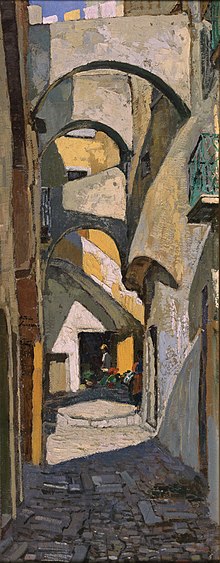Buttress

Vicolo di Formia (1956)
Oil painting by Antonio Sicurezza of an alleyway with buttresses between buildings
A buttress is an architectural structure built against or projecting from a wall which serves to support or reinforce the wall.[1] Buttresses are fairly common on more ancient buildings, as a means of providing support to act against the lateral (sideways) forces arising out of the roof structures that lack adequate bracing.
The term counterfort can be synonymous with buttress,[2] and is often used when referring to dams, retaining walls and other structures holding back earth.
Early examples of buttresses are found on the Eanna Temple (ancient Uruk), dating to as early as the 4th millennium BCE.[citation needed]
Contents
1 Terminology
2 Gallery
3 See also
4 References
5 External links
Terminology
In addition to flying and ordinary buttresses, brick and masonry buttresses that support wall corners can be classified according to their ground plan. A clasping or clamped buttress has an L shaped ground plan surrounding the corner, an angled buttress has two buttresses meeting at the corner, a setback buttress is similar to an angled buttress but the buttresses are set back from the corner, and a diagonal (or 'French') buttress is at 45 degrees to the walls.[3][4]
The gallery below shows top-down views of various types of buttress (dark grey) supporting the corner wall of a structure (light grey).
.mw-parser-output .mod-gallery{display:table}.mw-parser-output .mod-gallery-default{background:transparent;margin-top:0.5em}.mw-parser-output .mod-gallery-center{margin-left:auto;margin-right:auto}.mw-parser-output .mod-gallery-left{float:left}.mw-parser-output .mod-gallery-right{float:right}.mw-parser-output .mod-gallery-none{float:none}.mw-parser-output .mod-gallery-collapsible{width:100%}.mw-parser-output .mod-gallery .title{display:table-row}.mw-parser-output .mod-gallery .title>div{display:table-cell;text-align:center;font-weight:bold}.mw-parser-output .mod-gallery .main{display:table-row}.mw-parser-output .mod-gallery .main>div{display:table-cell}.mw-parser-output .mod-gallery .caption{display:table-row;vertical-align:top}.mw-parser-output .mod-gallery .caption>div{display:table-cell;display:block;font-size:94%;padding:0}.mw-parser-output .mod-gallery .footer{display:table-row}.mw-parser-output .mod-gallery .footer>div{display:table-cell;text-align:right;font-size:80%;line-height:1em}.mw-parser-output .mod-gallery .gallerybox .thumb img{background:none}.mw-parser-output .mod-gallery .bordered-images img{border:solid #eee 1px}.mw-parser-output .mod-gallery .whitebg img{background:#fff!important}.mw-parser-output .mod-gallery .gallerybox div{background:#fff!important}
Angled buttress
Clasping or clamped buttress
Diagonal or 'french' buttress
Setback buttress
Gallery

A buttress and a flying buttress, mostly concealed, supporting walls at the Palace of Westminster

Buttress at Our Saviour's Chapel, Żejtun, Malta
Façade buttresses at Milan Cathedral, Italy

Buttresses on the 700ft tall Daniel-Johnson Dam, Quebec

Thick buttresses characterize Earthquake Baroque architecture like Paoay Church, Philippines

Buttresses of the western side of the Mosque of Uqba in Kairouan, Tunisia
Buttresses to support the wall of this row house were constructed after its neighboring house was taken down as part of the Centralia mine fire.
See also
- Retaining wall
- Cathedral architecture
- Pilaster
References
^ "Buttress", www.britannica.com, Encyclopædia Britannica.mw-parser-output cite.citation{font-style:inherit}.mw-parser-output .citation q{quotes:"""""""'""'"}.mw-parser-output .citation .cs1-lock-free a{background:url("//upload.wikimedia.org/wikipedia/commons/thumb/6/65/Lock-green.svg/9px-Lock-green.svg.png")no-repeat;background-position:right .1em center}.mw-parser-output .citation .cs1-lock-limited a,.mw-parser-output .citation .cs1-lock-registration a{background:url("//upload.wikimedia.org/wikipedia/commons/thumb/d/d6/Lock-gray-alt-2.svg/9px-Lock-gray-alt-2.svg.png")no-repeat;background-position:right .1em center}.mw-parser-output .citation .cs1-lock-subscription a{background:url("//upload.wikimedia.org/wikipedia/commons/thumb/a/aa/Lock-red-alt-2.svg/9px-Lock-red-alt-2.svg.png")no-repeat;background-position:right .1em center}.mw-parser-output .cs1-subscription,.mw-parser-output .cs1-registration{color:#555}.mw-parser-output .cs1-subscription span,.mw-parser-output .cs1-registration span{border-bottom:1px dotted;cursor:help}.mw-parser-output .cs1-ws-icon a{background:url("//upload.wikimedia.org/wikipedia/commons/thumb/4/4c/Wikisource-logo.svg/12px-Wikisource-logo.svg.png")no-repeat;background-position:right .1em center}.mw-parser-output code.cs1-code{color:inherit;background:inherit;border:inherit;padding:inherit}.mw-parser-output .cs1-hidden-error{display:none;font-size:100%}.mw-parser-output .cs1-visible-error{font-size:100%}.mw-parser-output .cs1-maint{display:none;color:#33aa33;margin-left:0.3em}.mw-parser-output .cs1-subscription,.mw-parser-output .cs1-registration,.mw-parser-output .cs1-format{font-size:95%}.mw-parser-output .cs1-kern-left,.mw-parser-output .cs1-kern-wl-left{padding-left:0.2em}.mw-parser-output .cs1-kern-right,.mw-parser-output .cs1-kern-wl-right{padding-right:0.2em}
^ Chisholm, Hugh, ed. (1911), , Encyclopædia Britannica, 7 (11th ed.), Cambridge University Press, p. 315
Chisholm, Hugh, ed. (1911), , Encyclopædia Britannica, 7 (11th ed.), Cambridge University Press, p. 315
^ "Glossary : Buttress". www.lookingatbuildings.org.uk.
^ Edward Wyatt. "CHURCH ARCHITECTURE : SPIRES AND BUTTRESSES". www.prestbury.net.
External links
| Look up buttress in Wiktionary, the free dictionary. |
| Wikimedia Commons has media related to buttresses. |
Wikisource has the text of the 1911 Encyclopædia Britannica article Buttress. |










